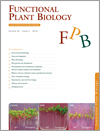
Functional Plant Biology
Volume 46 Number 5 2019
Trees heavily rely on water stored inside their stems during water shortage. This study addressed the stem water storage patterns of the mangrove Avicennia marina and discovered that the tree’s sugar transport system stored water during the daytime, a little observed phenomenon. The authors suggest this unusual adaptation could have a role in helping A. marina thrive in salty environments.
FP18314Ameliorating effects of exogenous Ca2+ on foxtail millet seedlings under salt stress
 , Mingjie Sun, Wei He, Xiumin Cui, Hong Pan, Hui Wang, Fupeng Song, Yanhong Lou and Yuping Zhuge
, Mingjie Sun, Wei He, Xiumin Cui, Hong Pan, Hui Wang, Fupeng Song, Yanhong Lou and Yuping Zhuge
Salt stress has started threatening regional development and could continue to threaten agricultural production and food security. The mitigation mechanism of Ca2+ of foxtail millet to salt stress is not only related to the yield and the patterns of saline-alkaline land utilisation but is also related to the food security of human beings. We examined the effects of different Ca2+ concentrations on foxtail millet growth, physiology, ion balance and gene expression under salt stress induced with 1.0% w/v NaCl, and found the optimal Ca2+ concentration to improve salt tolerance. This study provides theoretical and technical support for the cultivation of foxtail millet and the utilisation of salinised land with saline-alkaline soil.
FP18163Isobaric tags for relative and absolute quantitation-based quantitative proteomics analysis provides novel insights into the mechanism of cross-incompatibility between tree peony and herbaceous peony
Tree peony, known as the king of flowers, can be improved and bred by interspecific hybridisation. To elucidate the molecular mechanisms of the cross-incompatibility between tree peony and herbaceous peony, six differentially expressed proteins containing enolase, DnaK, GroEL, calmodulin, adenine nucleotide translocator and glyoxalase I were found by isobaric tags for relative and absolute quantitation-based quantitative proteomic analysis. These results should facilitate interspecific hybridisation in agricultural practice.
FP18272The VvBAP1 gene is identified as a potential inhibitor of cell death in grape berries
A type of programmed cell death in grape berries occurs late in ripening influencing yield via berry shrinkage, and ultimately affecting wine quality. A gene transcript (VvBAP1) linked to cell death in the grape berry has been discovered that also confers ROS and drought tolerance to Arabidopsis when overexpressed. This discovery will allow future research to uncover the downstream regulators of berry cell death that occurs only in some cultivars of grapevine.
The factors that increase the levels of toxic quinolizidine alkaloids (QAs) in the grain legume narrow-leafed lupin are poorly understood. We hypothesised that jasmonates are involved in regulating QA biosynthesis in response to biotic stresses. We identified that methyl jasmonate induces QA biosynthesis in high-QA narrow-leafed lupin, but observed no response in low-QA narrow-leafed lupin. Furthermore, predation by aphids – a major insect pest of narrow-leafed lupin – did not affect QA levels in low-QA cultivars.
FP18278 Abstract | FP18278 Full Text | FP18278PDF (416 KB) | FP18278Supplementary Material (283 KB) Open Access Article
FP18258Amplification of abiotic stress tolerance potential in rice seedlings with a low dose of UV-B seed priming
UV-B seed priming is a means of inducing abiotic stress tolerance in a cost-effective manner with appropriate and essential expenditure of energy towards stress tolerance. This priming method effectively influence various physio-chemical features in the rice seedlings under different stress conditions and brings about more positive stress tolerance features for NaCl stress than for PEG and UV-B stress.
Is mesophyll involved in stomatal responses to environmental stimuli? The mesophyll segments of Commelina communis pretreated in the light at low CO2 air were more effective to induce stomatal opening in the epidermal strips transplanted from the plants kept in the dark than those pretreated in the dark and/or high CO2. Our results indicate the involvement of mesophyll in stomatal responses.
FP18241Heterologous expression of rice RNA-binding glycine-rich (RBG) gene OsRBGD3 in transgenic Arabidopsis thaliana confers cold stress tolerance
 , Amit K. Singh, Senthilkumar K. Muthusamy, Shuchi Smita, Viswanathan Chinnusamy and Kailash C. Bansal
, Amit K. Singh, Senthilkumar K. Muthusamy, Shuchi Smita, Viswanathan Chinnusamy and Kailash C. Bansal
Cold stress leads to major crop losses in many parts of the world, so identifying key genes of agronomic importance could provide a sustainable solution to this problem. We have identified the key role of a rice gene (OsRBGD3) attributed to cold tolerance, root elongation and early flowering. Use of this gene will provide agricultural industry an opportunity for breeding future frost-resistant and early flowering crops.



